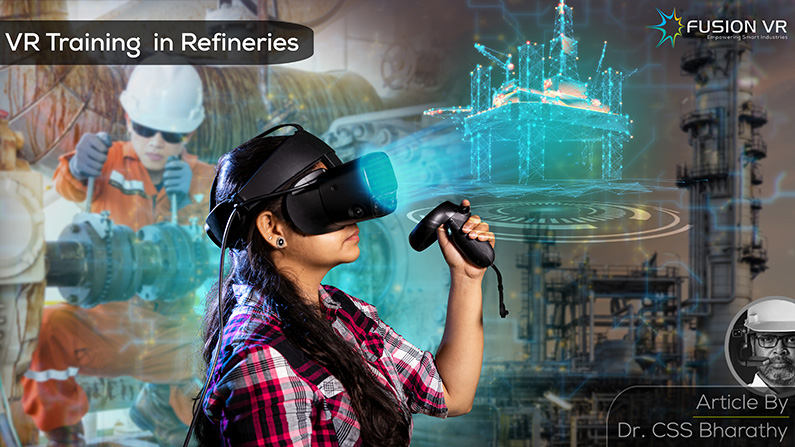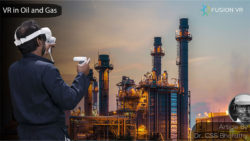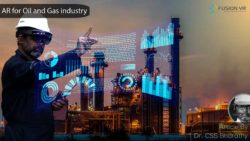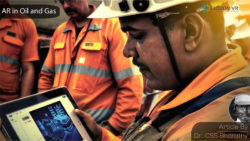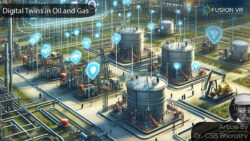How conventional training happens in oil refineries and explore how VR solutions can transform that experience to deliver better results and achieve long term excellence
Introduction
A refinery delivers the energy and critical intermediates for the products that are essential to our lives. These refineries need to operate safely so that they can keep the wheels of the national economy in motion. An outage or an accident can put the brakes on and result in huge supply chain challenges, putting millions of people in difficult and challenging situations. One of the major reasons for such events is human error and the best way to reduce that is through effective training of all employees and contractors in a refinery environment. Such training also creates a positive safety culture in the facility and everyone works together to send everyone home safe each day.
Training employees to achieve necessary work competencies haven’t changed much in the past three decades in the manufacturing industries. Virtual Reality (VR), Augmented Reality (AR) and Mixed Reality (MR) are Industry 4.0 technologies could just change the way train personnel and deliver safety and operational excellence with the Fourth Industrial revolution.
Safety is a top priority in all refineries and it is evident the moment anyone enters such a facility. Detailed safety procedures, compliance training and audits are conducted frequently to ensure safe outcomes with personal and process safety. The risk of injury is greatest in the course of performing operational or maintenance tasks.
Mechanical maintenance work in a refinery typically involves opening equipment, overhauling, dismantling piping and equipment, performing repairs and restoring back to service. This is always manual work with the aid of mechanized tools and there is always the possibility of physical injury when performing such work, particularly to the hands. Most of these equipment handle highly hazardous materials that have the potential for exposure and cause injury. Crude oil is a hazardous material and comes with toxic contaminants such as hydrogen sulfide. It is therefore extremely critical to ensure safe execution of work and also the safe return to service of such equipment. The best operating plants place considerable emphasis on ensuring this through better procedures and training.
Maintaining High Safety and Performance Standards
Companies use a variety of metrics to track the safety performance at the plant. They track the number of incidents and near-misses and investigate them to understand root causes, eliminate at risk behaviors and conditions and prevent recurrence of such events at their facilities. When injuries do happen, they are categorized as first aid injuries and recordable injuries. Many project organizations and construction companies also use lost-time-injury as a safety performance metric. These metrics are also closely tracked and many companies have achieved years of injury free operations. Achieving such results takes significant commitment and teamwork from all employees built on a foundation of excellent safety procedures and training.
Typical Training at a Refinery
Refinery training typically begins with employee orientation and covers essential safety procedures. They also train personnel on permit to work, lock out tag out, confined space, work at heights, electrical safe work, scaffolding, lifting operations, vehicle safety etc. Training on these procedures instruct on the right way to perform work and help reduce the risk of injury and fatalities. The training is always delivered in classrooms using slide presentations. Most of the information is textual with some pictures to illustrate the essential concepts of these procedures with the occasional video. While the information shared is useful, the mode of delivery is simply uninteresting.
The practical component of this training if any, is usually small and exercises are performed in groups in the interest of time. Ensuring individual understanding of all concepts through practice is not feasible. Performing such exercises in the real plant environment is not possible as it will interfere with plant operation and could cause unintended injuries as well. While conventional training approaches ensure safety of the participants, it doesn’t usually deliver the understanding and the competency necessary. Employees often get that only during their on-the-job training or when the process units experience maintenance outages and turnarounds. The ability to view the internals, its arrangement and the condition of equipment after years of operation is available to few present on that day at the refinery. These type of learning opportunities are rare in high reliability organizations where most employees complete many years of service without gaining these crucial experiences. While there are SOPs and SMPs (Standard Operating Procedures & Standard Maintenance Procedures) that detail all actions to be performed, it is usually a poor substitute for hands on training, resulting. Human error is a significant cause for all incidents, injuries and outages. Repetitive training and practice is required to master maintenance skills and reduce errors. There is a clear need to do something different in order to achieve the desired performance goals and using VR is the way forward.
How VR Training will help
Virtual reality is a computer generated 3D environment that the user feels immersed in with the use of a specially designed headset. This environment can be designed to appear highly realistic and often tricks the human mind into believing that it is really part of that virtual environment.
The refinery environment with its various equipment, piping, valves, instrumentation and structural elements are modeled in 3D and are designed to appear highly realistic with the required lighting, texture, physics simulations etc. Imagine yourself to be in a virtual plant environment with the ability to move about and view in all directions. Such capability allows the user to perform any kind of activity that is typically performed by any function in the refinery setting. This could be a plant operator, supervisor, technician or an emergency response crew member.
Training of personnel can now be conducted with virtual reality solutions in a completely virtual plant environment. This highly realistic virtual plant can be a section of the unit or the entire facility itself. Operators can be trained on basic operations fundamentals and specific tasks as required by the unit’s Standard Operating Procedures (SOP). Similarly, they can be trained on maintenance activities as per the facility Standard Maintenance Procedures (SMP).
Effectiveness of VR Training
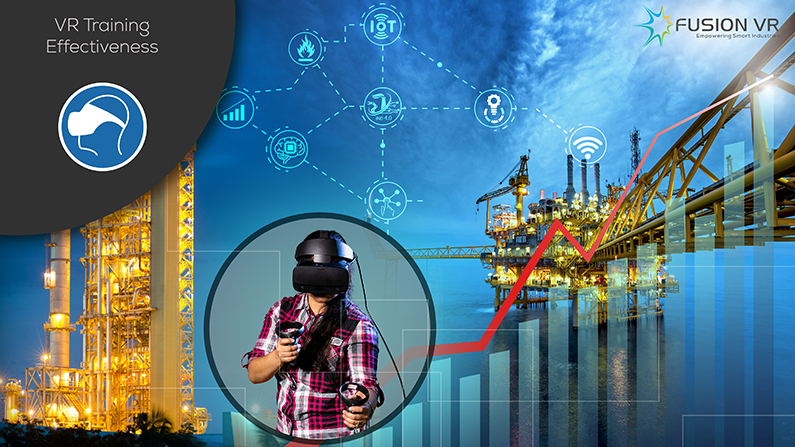
PWC in its report titled, Seeing is Believing highlights the economic benefits of VR in learning and development. They reported that VR training is four times faster than the typical classroom training and 3.75 times more emotionally connected than other kinds of training. The industry is expected grow and could contribute nearly 294 billion dollars to the world economy by the year 2030. That indicates how important this technology is and the scale of opportunities for the business community in VR. Several companies have initiated projects to implement virtual reality training for operations, maintenance and safety personnel.
VR Training in Depth
With the experts concurring on the effectiveness of VR in training, let’s look at how it can be done. The complete virtual model of the plant needs to be developed that is exactly the same in terms of scale, appearance and feel. All process data needs to be simulated from the existing control systems so that the parameters observed in the virtual plant. The training is provided with voice over and text based instructions for the operator to perform tasks as specified in the SOP. All operations including start up shutdown, normal and emergency operations can be performed. This system is independent and does not affect plant operations. The mistakes that operators make can be captured and feedback given. Since this is in the virtual space, the training is pretty much gamified and there is no real consequence.
Many learn through repetition of these actions in the VR module and receive feedback on areas to improve. This is the biggest advantage of VR as it helps establishes safe operating habits leading to improved operational discipline. The same applies for maintenance personnel, who for example, can learn how to obtain a permit to work and perform necessary actions to safely remove a piece of equipment and work on it. The knowledge and familiarity with the equipment in the VR space will translate towards better success during actual execution.
Operations & Maintenance Training
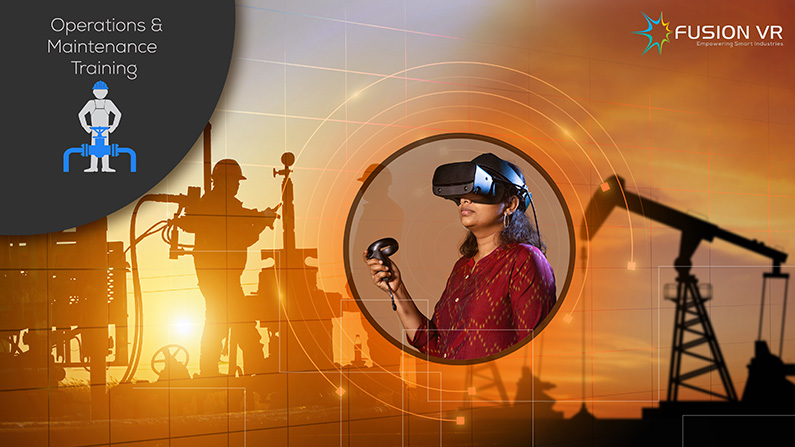
When plants face operational or safety emergencies, plant personnel usually resort to the SOPs or EOPs (Emergency Operating Procedures) for necessary instructions. There is a perceptible delay in first actions since the operator is a bit surprised or shocked at the abrupt development. Knowing what to do in an emergency, the steps to be taken to secure the plant to a safe condition requires extensive training. While scenarios are rehearsed on a table top exercise, practicing these actions in a VR multiplayer module enhances understanding and generates better preparedness when such situations happen. VR training enables an operator to understand the design of the equipment, its components and their function with exploded and x-ray views. The understanding is enhanced, which allows them to operate properly and troubleshoot problems more effectively.
Proper preparation of equipment for maintenance by operations personnel and its safe return to service is one the major process safety challenges in a refinery. Proper deinventory and freeing the system of hydrocarbons and other hazardous materials is taught and practiced step by step in the VR space. VR training instructs operators on how to isolate all energy sources, lock and tag them and ensure the equipment of system is handed over to the maintenance crew to execute their work safely. Such training ensures that exposures and stored energy hazards are eliminated and every employee laying their hands on the job is safe at the end of the day.
In the maintenance world, VR training provides numerous opportunities for engineers and technicians to understand the arrangement of the equipment. For example, a employee does not need to grapple with complex two dimensional general arrangement drawings or section drawings to understand how a mechanical seal is built or assembled. The VR module enables guided disassembly and assembly of the seal and its proper installation on a pump shaft. The entire exercise can be simulated and even gamified to make it more interesting. The goal here is also to enhance understanding, so that there is no mistake when complex machinery are serviced or repaired during an outage. Not only is it done right, it avoids rework which is a leading cause for safety incidents and cost excursions.
VR Training Solutions
These VR training solutions can be delivered to fresh employees, existing employees for certification and recertification training and also simulate specific operations activity to ensure broader success and compliance. Even supervisors, managers and almost everyone can train on VR modules to learn the necessary skills. VR training provides the exact kind of training to all employees in a totally safe environment. There’s no impact at all to regular operations. The training is delivered in specially designed solutions such as VR Operator Training Simulator (VR-OTS) and VR Maintenance Training Simulators (VR-MTS). These simulators are operational not only in refineries but also at technical institutions which prepare students for operations and maintenance jobs in the industry.
VR is known to be extremely popular and successful in the gaming world and is now making a strong foray in the manufacturing space. Keeping all employees safe is of paramount importance in refineries. VR solutions present a novel approach to training and retaining employees and helping the refinery facility remain safe is crucial. There are leading VR companies in India with the experience and expertise to develop customized solutions. They also provide AR and MR solutions to meet the needs of the petroleum refining industry. This type of expertise is not usually available. Only a few companies VR development companies in India like Fusion VR have the domain knowledge of Oil & Gas, Refining and Petrochemical industries along with the expertise in VR, AR and MR technologies. Such capabilities make it easier for technical teams from these industries as they speak the “same language”, understand industry “pain points” for developing proper use cases and the most effective VR solutions.
Strategic Choices for Leadership Teams
Chief Operating Officers, Plant Managers and Operations Managers must experience first-hand the power and effectiveness of VR training. They become believers and acquire the strategic vision to form teams, allocate necessary capital and provide the leadership support to implement the projects identified. Increased digitalization and rapid adoption of Industry 4.0 technologies is the way to operate effectively and deliver a competitive advantage for companies in this increasingly globalized marketplace. Supply chains have become more cost efficient that it is practically possible to manufacture and ship from anywhere in the world.
All of the above is possible in a safe operating facility that has highly trained and motivated employees with a great safety culture. Their daily efforts to deliver operational and safety excellence is the essential ingredient for sustained success in the refining industry.
Dr. CSS Bharathy, Founder, Fusion VR, India is a Certified Industry 4.0 Expert with nearly three decades of experience in this industry. He has authored many publications and addressed key industry conferences.

